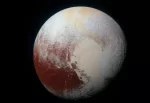Ever since Pluto was discovered, the planet has not completed a single orbit around the Sun. Astronomers will have to wait longer to celebrate the completion of the first round.
Pluto was discovered on 18 February 1930 at the Lowell Observatory in Flagstaff, Arizona. American astronomer Clyde Tombaugh clearly observed a moving object outside the orbit of Neptune. Later it was called Pluto. Pluto was given his name after a Greek emperor.
Pluto has always been debated whether it is a planet or a dwarf planet. However, taking its orbit into account, astronomers believe that since Tombaugh first observed Pluto, it has yet to orbit the Sun.
Pluto’s first orbit will be completed in 248.09 years
It will take 248.09 years for Pluto to complete one orbit around the Sun. The Timeanddate.com calculator shows that Pluto will complete its first orbit on March 23, 2178.
The large worlds in our solar system orbit near the ecliptic, which is the plane of the solar system. However, Pluto is tilted 17 degrees relative to Earth and several other planets. Scientists say that the minor planets are tilted more, Mercury and Eris at seven degrees, Makemake at 29 degrees, and Haumea at 28.2 degrees.
Read More: NASA Trending Post: NASA Shares ‘Final Selfie’ of InSight Mars Lander, Post Viral.
Earth’s orbit is roughly circular, with Pluto’s eccentricity being 0.25. Compared to the rest of the planets, the eccentricity of Mercury is 0.205, that of Eris is 0.44, that of Makemake is 0.16 and that of Haumea is 0.20.
4 Important Things in Pluto’s Orbit
New Horizons principal investigator Alan Stern of the Southwest Research Institute says there are 4 things to consider about Pluto’s orbit – the first two being its inclination and eccentricity. The third is Pluto’s resonance with Neptune. The fourth is what is caused by that resonance.
Stern says that Pluto comes closer to the Sun than Neptune. It works like a clock. When this happens, Neptune is always on the opposite side of the Sun. Since these two are in the same resonance, they can never collide.
Pluto’s largest moon is Charon
NASA’s New Horizons mission co-investigator Will Grundy has also added a fifth element – Pluto and its largest moon Charon – to Pluto’s orbit. which are almost identical in size. Charon is about half the mass of Pluto. Grundy says that instead of treating Pluto as a separate world, one should think of the common center of mass that Pluto and Charon share when they orbit the Sun. He says that Pluto and Charon are actually double planets and should be taken into account when mapping the system’s orbit.
Pluto comes from the region astronomers call the Kuiper Belt. This world is icy and the objects here are called Kuiper Belt Objects (KBOs). As Pluto moves in its orbit, it is sometimes closer to or sometimes farther from the Sun. and reacts to strong or weak sunlight.



